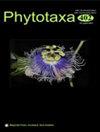Ceropegia strophanthiflora(Apocynaceae-Asclepiadoideae)--南非濒临灭绝的珍稀新物种
IF 1
4区 生物学
Q3 PLANT SCIENCES
引用次数: 0
摘要
我们描述了南非夸祖鲁-纳塔尔省北部 Mtubatuba 内陆的一个 Ceropegia(Apocynaceae-Asclepiadoideae-Ceropegieae)新种 C. strophanthiflora。该新种被归入 Chamaesiphon 部分,在该部分中,它似乎与 C. rehmannii(原名 Brachystelma foetidum)在植物学和植物学上最为相似。不过,Ceropegia strophanthiflora 很容易与该种区分开来,因为它的花朵呈黄绿色,色彩鲜艳,花冠裂片基部有明亮的紫色斑纹和紫粉色振毛。不过,最引人注目的是花冠裂片异常细长、扭曲,很容易让人联想到石莲花,因此被命名为石莲花。目前还没有其他已知的南非物种开出如此艳丽的花朵。令人担忧的是,这个壮观的新物种可能濒临灭绝,因为它的栖息地所剩无几,受到了严重的人为威胁。 Brachystelma tanzaniense 是坦桑尼亚的一个物种,具有细长的花冠裂片。此外,这次转移的阻挡名 C. tanzaniensis 被降为 C. cordiloba 的异名,我们为其指定了一个讲座模式。本文章由计算机程序翻译,如有差异,请以英文原文为准。
Ceropegia strophanthiflora (Apocynaceae—Asclepiadoideae)—a magnificent and rare new species from South Africa at the brink of extinction
We describe a novel species of Ceropegia (Apocynaceae-Asclepiadoideae-Ceropegieae), C. strophanthiflora, from inland of Mtubatuba in northern KwaZulu-Natal, South Africa. The new species is placed in section Chamaesiphon where it appears to be vegetatively and floristically most similar to C. rehmannii (formerly Brachystelma foetidum). Ceropegia strophanthiflora can, however, be readily distinguished from this species by its strikingly colourful greenish-yellow flowers with bright purple markings and purplish-pink vibratile hairs fringing the corolla lobe bases. Most remarkable, however, are the unusually long, slender and twisted corolla lobes much reminiscent of flowers known in Strophanthus; hence the name C. strophanthiflora. There are no other known South African species exhibiting such flamboyant flowers. Concerningly, this spectacular new species may be at the brink of extinction as only very little habitat remains which is under severe anthropogenic threat. Brachystelma tanzaniense, a species with long and slender corolla lobes from Tanzania, is transferred to Ceropegia section Chamaesiphon under the proposed new name C. dodomaensis. Moreover, the blocking name for this transfer, C. tanzaniensis, is reduced to a synonym of C. cordiloba for which we designate a lectotype.
求助全文
通过发布文献求助,成功后即可免费获取论文全文。
去求助
来源期刊

Phytotaxa
PLANT SCIENCES-
CiteScore
1.90
自引率
27.30%
发文量
956
审稿时长
1 months
期刊介绍:
Phytotaxa is a peer-reviewed, international journal for rapid publication of high quality papers on any aspect of systematic and taxonomic botany, with a preference for large taxonomic works such as monographs, floras, revisions and evolutionary studies and descriptions of new taxa. Phytotaxa covers all groups covered by the International Code of Nomenclature foralgae, fungi, and plants ICNafp (fungi, lichens, algae, diatoms, mosses, liverworts, hornworts, and vascular plants), both living and fossil. Phytotaxa was founded in 2009 as botanical sister journal to Zootaxa. It has a large editorial board, who are running this journal on a voluntary basis, and it is published by Magnolia Press (Auckland , New Zealand). It is also indexed by SCIE, JCR and Biosis.
All types of taxonomic, floristic and phytogeographic papers are considered, including theoretical papers and methodology, systematics and phylogeny, monographs, revisions and reviews, catalogues, biographies and bibliographies, history of botanical explorations, identification guides, floras, analyses of characters, phylogenetic studies and phytogeography, descriptions of taxa, typification and nomenclatural papers. Monographs and other long manuscripts (of 60 printed pages or more) can be published as books, which will receive an ISBN number as well as being part of the Phytotaxa series.
 求助内容:
求助内容: 应助结果提醒方式:
应助结果提醒方式:


